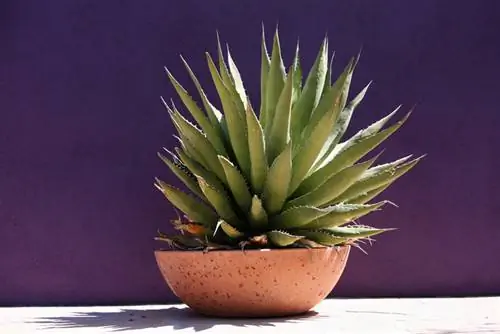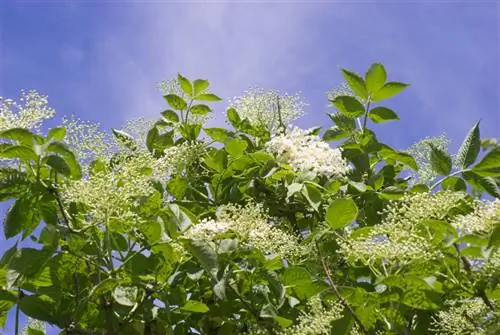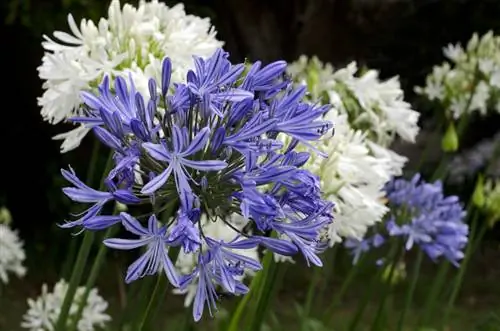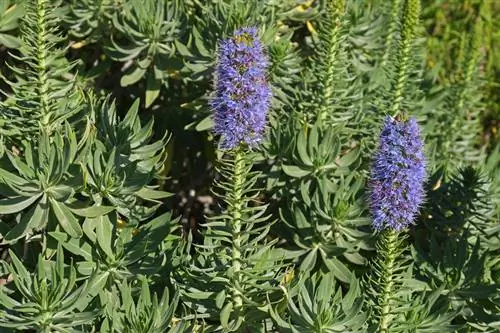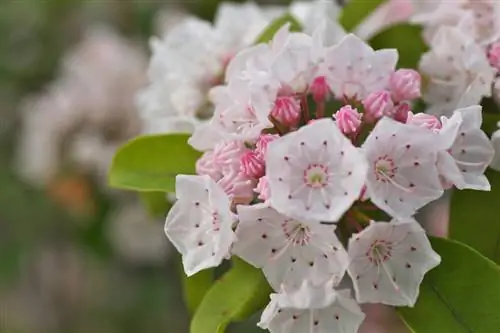- Author admin [email protected].
- Public 2023-12-16 16:46.
- Last modified 2025-01-23 11:20.
Agave is a succulent plant that originally comes from the American continent. The plants from the asparagus family, which are often associated with cactuses due to their properties, were planted in parks and gardens in the Mediterranean region centuries ago and are now also popular plants in private gardens.
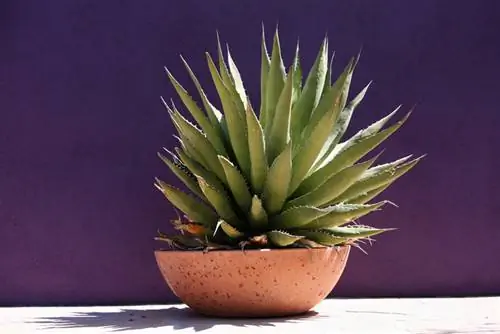
How do I care for agave plants properly?
Agaves require sparing watering during the growing season, every few days in midsummer and rarely in winter. They are optimally fertilized every two weeks in summer, never in winter. Repotting is useful every 1-2 years, and pruning is usually unnecessary.
How often should agaves be watered?
As plants originally native to deserts and semi-deserts, agaves need as sunny a location as possible for he althy growth. The plants are adapted to a climate with irregular rainfall and store a lot of water in their thick leaves. Agaves in the garden bed or pot should only be watered when the top layer of soil around the plants has dried. The root ball below the leaf rosette cannot tolerate waterlogging, but it must never dry out completely. In midsummer you should water agaves sparingly every few days, but in winter quarters the plants should hardly be watered. As soon as the leaves become thin and wrinkled, agaves should be watered urgently.
What should you consider when repotting agaves?
Agaves are relatively unproblematic when it comes to repotting; they are usually moved to a slightly larger planter every one or two years when the plants are wintered out in the garden. A mixture of two thirds potting soil and one third sand (e.g. quartz sand) should always be used as the substrate. Larger stones and holes in the lower area of the planter prevent dangerous waterlogging in the root area of the agaves.
When and how should agaves be cut?
Since the leaf rosettes of the agave grow very compactly, it is generally not necessary to prune these plants. Yellow or rotten leaves should be cut off early, as close to the base as possible, without damaging the stem of the plant. This removal of dead leaves results in a trunk-like, woody plant base in particularly old specimens over time.
Which pests can be dangerous to agaves in the garden?
The very robust agaves are occasionally attacked by the following pests:
- Scale insects
- mealybugs
- Palm weevil
You can tackle scale insects and mealybugs relatively easily with a sponge and a small amount of detergent solution. Unfortunately, there is currently no effective antidote against the larvae of the notorious palm weevil.
Are there any common diseases that affect agave plants?
Agaves are not really often affected by diseases in this country. If the leaves become discolored or die, this is usually due solely to care errors such as soil that is too moist.
How is the agave optimally fertilized?
During the winter period you should not fertilize the agave at all; in the summer months you can fertilize sparingly with a suitable complete fertilizer in the irrigation water about every two weeks.
What should you consider when overwintering the agave?
While many agaves can only tolerate slightly sub-zero temperatures for short periods of time, other species can survive the winter outdoors with a certain amount of winter protection. You should therefore pay close attention to the care instructions for your respective agave specimens. Non-frost-hardy agaves are ideally overwintered indoors at around 4 to 14 degrees Celsius in a bright location. If you do not have an appropriately temperature-controlled and bright stairwell, basement or attic room, a rather cool room in the apartment such as the bedroom can also be an option.
Tip
There are many different types of agave, which differ not only in their frost tolerance, but also in their growth speed and size. Over the years, an agave cultivated in a pot can reach dimensions that make the move to winter quarters and back to the garden a real feat of strength. For year-round care on the windowsill, you should choose agaves from specialist retailers, which are generally slow-growing and remain relatively small.

